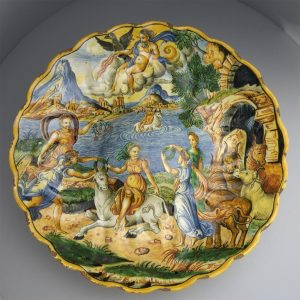The interpretations of ancient stories have changed throughout history. Europa and the Bull is a prime example of a story whose interpretation has been changed since the classical era. Europa and the Bull was originally a Greek mythological story that, throughout the course of time, developed different meanings from literal to metaphorical. These adaptations were represented through the artwork, more specifically, the landscape of the piece. By using the landscape to frame the story or scene represented, the message conveyed is shifted. This is apparent in many renaissance artworks. Centuries after the ancient Greeks, Christians were using these stories to represent their moral values through artwork. Artists such as Titian would depict scenes from prominent Roman and Greek tales. By using the landscape, the renaissance artists would retell these ancient stories either from their perspective or fit the commissioner of the piece.
The Renaissance in Italy was a time where moral values were derived from Christianity. The art reflected Christian icons or stories that represented the values that pertained to the church. However, not all these stories were found in the bible. Europa and the Bull is a Greek story about a woman, Europa, who was kidnapped by Zeus who turned himself into a bull, kidnapped her, and kept her on the island of Crete While the tale derived from classical mythology, this fable can be found on paintings, dishes, and sculptures throughout the mid-1500s by well-known artists. This is because many themes were considered to portray Christian values. Even Christian prayer books dating back to the late 16th century told those to “…respect the Oriental notions in the…Greeks…” because their literature had similar ideologies and values of the church. The mythological stories that mirrored the values of the church were then illustrated on large canvases and household items. The simplistic mythological story was perfect for anyone in the household to understand. In Italy during the Renaissance, only an average of 20% of the adult male population was literate; woman and children, in this time period, were uneducated. A painting/illustration of a woman being abducted by a higher being such as a god was supposed to tell women in the Renaissance period to be true and loyal to their husbands. Stories that represented woman’s loyalty to their husbands were commonly given as wedding gifts, usually illustrated on a maiolica. A maiolica is a dish that illustrated ancient mythology, classical history, and stories from the Bible These were commonly given as gifts or ordered in sets by wealthy Italian families. The piece Molded Dish with Europa and the Bull (c.1550) is a maiolica that displays the complete story of Europa and the Bull, which, according to the Ackland Art Museum Object Guide, was most likely given to a new wife on her wedding day (picture of piece displayed below).
In 16th century artwork, the color white was symbolic of power, deity, and purity. Of all the bright colors, Zeus in bull form is the only white part of the landscape, representing his godly status as a supernatural being who has control of all humans below. Along with white, the blue scarf on Zeus can represent a “steady character” or wisdom. Many western artists used the color blue as it is a formal color that represents wisdom, strength, and importance. The human form of Zeus also sits atop a cloud, almost disconnected from the story as if he is watching all the scenes play just like the viewer of the piece. While the animals and humans throughout the landscape show happy emotions, the meaning of the story is to suppress and keep woman “obedient”. By displaying the animals with these emotions, the moral meaning of staying loyal and obedient to your husband is delivered as good, giving off the tone that if your husband is happy, you will be happy.
This adaptation of Europa and the Bull, like many adaptations of Robinson Crusoe, added Christian values to retell the story “appropriately” to the people during this time period. The common idea that a wife is obedient to her husband and following a moral code was prominent throughout the church, especially in Italy during the 16th century. The church birthed, educated, fed, wed, and buried you during this time period, therefore, the artwork would reflect the dominant ideology. Through visual examination and color theory, it is apparent that key details helped determine the meaning of this piece and helps the viewer understand that it is an adaptation of the original story.

